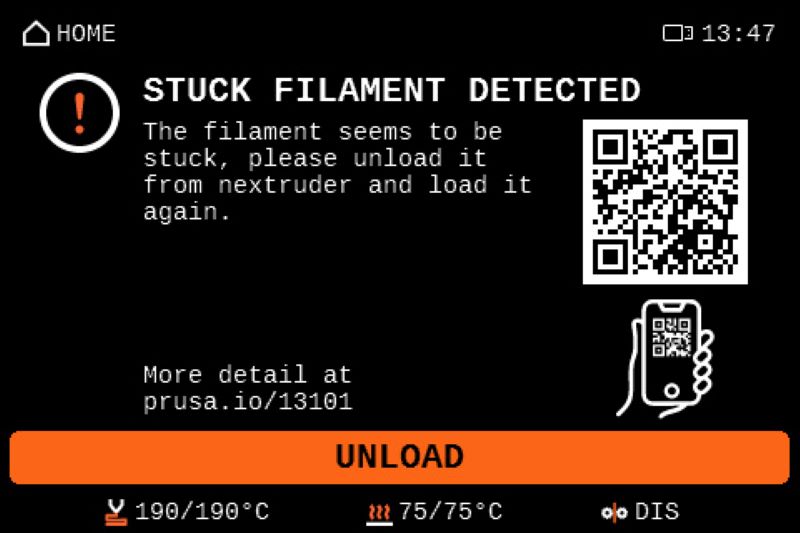The Prusa CORE One, CORE One L, and the Original Prusa XL, MK4/S, MK3.9/S are equipped with a loadcell. Thanks to this component, starting from firmware 6.0.0, the printer can detect whether the filament is stuck and not moving, for example when the nozzle is clogged.
If this is detected, the print pauses and the printer shows the message: "Stuck filament detected. The filament seems to be stuck. Please unload it from the extruder and load it again."
Once the unload button is pressed, the printer unloads the filament. After this, it prompts filament loading and resumes the print.

Repeated detections
Loadcell troubleshooting
In case of multiple, repeated stuck filament detections in rapid succession, troubleshoot the loadcell and the components around it, using the steps in the dedicated loadcell troubleshooting article.
Temperature and speed settings
If loadcell troubleshooting does not improve the multiple and repeated detection, consider slight changes to temperature and slight reductions in the movements and extrusion movements. Those can be set individually through PrusaSlicer, or in a single print speed setting, mid-print, using the Tune menu.
Deactivating the detection
It is possible to deactivate the stuck filament detection in LCD Menu -> Settings. Deactivating the detection comes with an increased risk of nozzle clogging.
30 comments
I sent an earlier comment on the filament load TS section but now realize it is stuck filament error (engineers don't always look at error codes).
I too hear clicking but realized it is not in the extruder/PG but is when the extruder nozzle passes over the rough areas of the buffer region when purging the dispense nozzle. I turned off the "Stuck Filament Detection" and the print completed without issue. The dispensing in the buffer region to purge is what the load sensor is being impacted by. It does not happen on first passes as the surface is smooth. But as layers are put down and the filament changes colors the buffer region has stringers and missing regions that the nozzle/load sensor detects.
I built my unit and have had no issues with single color objects. I am only now using the MMU3 capability and saw stuck filament errors.
Not sure if something needs to change in the buffer region algorithm when changing filament color to smooth the region out or if it is defined in the sliced 3D model themselves. I am a newbie to 3D printing. Be curious if delwilson6241 had similar problem.
Look forward to your reply.
I've been experiencing some issue with XL5T.
I'm printing an ABS part with PLA supports. Not the first time, so works well for me.
With the particular part, i'm experiencing this error "Stuck Filament Detected" exactly on the same point of printing.
I've cleaned the extruder - same problem;
Changed the extruder to (T4 from T2) regenerated the program - same problem. Exact same spot.
I've checked the g-code, no unexpected E values.
Would you be able to assist?
Thank you in advance,
PRUSA YOU NEED TO FIX THIS111
It's very troubling that Prusa has not addressed this problem and taken corrective action. With the increasing competition from other vendors, failure to address and correct widespread problems will cost them customers over time.
It doesn't matter how many cool features they add to a new product it must be robust and reliable in its operation.